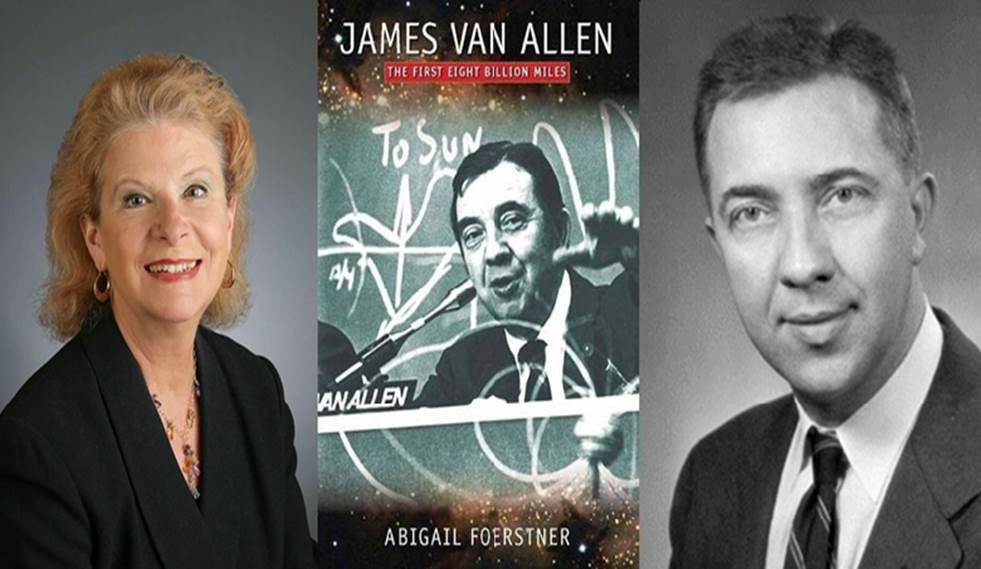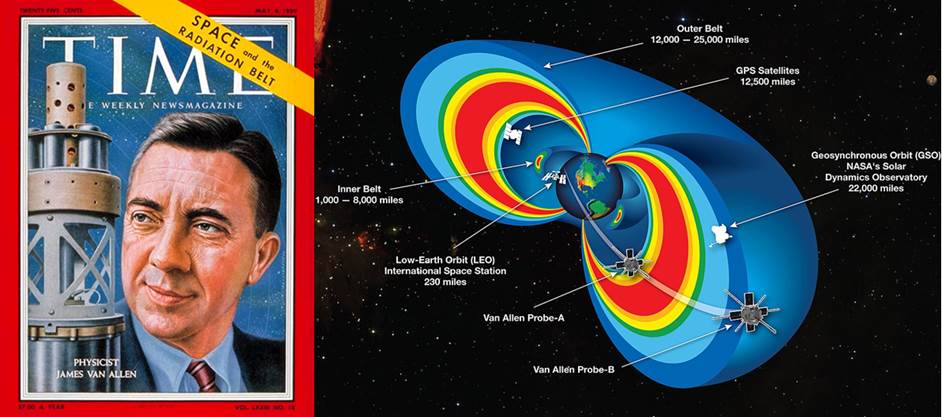Book & Author
Abigail Foerstner: James Van Allen— The First Eight Billion Miles
By Dr Ahmed S. Khan
Chicago, IL

“… Are individuals the deciding factor in events or do events create roles that any number of people could fill? The discovery of the radiation belts offers a compelling case study for how individuals and events interplay in the drama of human affairs. Van Allen's discovery of the belts relied on hard scientific know-how as well as quirks of individuality and fate”
The National Aeronautics and Space Administration (NASA) came into existence on October 1, 1958, as result of the National Aeronautics and Space Act signed by president Eisenhower on July 29, 1958. During the past 65 years NASA has pioneered new fields of aeronautics, earth and space science, and exploration. Today space science is a well-developed field. But many people do not know much about the physicist — James Van Allen — whose pioneering work led to many new fields of space science and exploration and which eventually led to the establishment of NASA.
James Van Allen— The First Eight Billion Miles by Abigail Foerstner charts the biography of the trailblazing physicist through scientific, technological, political, and academic events. “The First Eight Billion Miles” in the title refers to spacecraft Pioneer's travelling 8 billion miles in deep space before it fell silent after sending its last faint signal on January 22, 2003.
The author spent seven years researching and writing the book. Professor Foerstner teaches graduate courses in science writing and news writing at Northwestern University’s Medill School of Journalism. She worked for the Chicago Tribune for about ten years covering suburban, science and environment sections. She has penned a plethora of articles on science, history and visual arts. She has also authored a book “Picturing Utopia: Bertha Shambaugh and the Amana Photographers."
In addition to the preface and introduction, the book has eighteen chapters: 1. Frontier Roots, 2. Heartland Boyhood, 3. The Making of a Scientist, 4. Physicists to the War Effort, 5. Enter Abigail Fithian Halsey, 6. The Dawn of Space Exploration, 7. The Mighty Little Aerobee, 8. It's a Rocket! It's a Balloon! It's a Rockoon! 9. Sputnik and the Space Race, 10. Countdown to Explorer I, 11. Celebrity Scientist and the Birth of NASA, 12. Discovery of the Radiation Belts, 13. Space Shield for the Cold War, 14. Space as a Cottage Industry, 15. The Mariners, 16. Pioneers to the Outer Planets, 17. Space Politics, and18. Journey to the Edge of the Solar System.
In the preface the author, highlighting the importance of Iowa city in the domains of physics and metaphysics, observes: “The corner of Jefferson and Dubuque Streets in Iowa City surely marks one of the world's epicenters for physics and metaphysics. Within a block, St Mary's Catholic Church, the First United Methodist Church, the Congregational United Church of Christ, and Gloria Dei Lutheran Church give voice to meta-physics. At the intersection itself, Van Allen Hall anchors the University of Iowa's Department of Physics and Astronomy… He had a reputation as a practical physicist who applied the lessons of small-town Iowa ingenuity to outer space.”
Acknowledging Dr. James Van Allen’s cooperation in writing the book, the author observes: “My thanks first and foremost to Dr James Van Allen for his time, his teaching, and his trust in giving me carte blanche to research all his papers, diaries, and other documents in Room 701. He was a great teacher and he taught me sixty years of space science and technology to supplement the one year of college physics I studied as a journalism major. He explained the intricacies of radiation belts, magnetospheres, and the solar wiind—cornerstones for new branches of physics he helped establish. We met at 1:30 PM on Monday, Tuesday, and Wednesday on the third week of every month for interview sessions for more than two years. There were numerous trips to his office after that to fill in gaps and check facts. Van Allen turned hard-nosed science into a riveting space adventure.”
Describing Dr Van Allen’s pioneering contribution to space science, the author states: “Van Allen pioneered the field of space science, discovered the earth's radiation belts and helped draw a new map of the solar system on his journey across 8 billion miles. His instruments on board more than two hundred rockets, satellites, and space probes transmitted data over six decades. Pioneer 10 alone, launched for a twenty-one-month mission in 1972, sent Van Allen more than thirty years of readings that helped us recognize that the boundary of the solar system extended billions of miles past Pluto. Van Allen's career crystallizes the entire history of space exploration. He and a group of freewheeling colleagues launched the era of space exploration with captured German V-2 rockets reassembled and launched at the White Sands Proving Ground [now the White Sands Missile Range] in New Mexico after World War II. Partnering with the US Army, the scientists replaced the warheads of the ‘vengeance machines’—that had terrorized London and Antwerp—with scientific instruments little more than a year later. Van Allen helped found and later chaired an informal rocket panel that met monthly to divvy up the V-2s—and later rocket missions—and to provide a forum for the new field of space science. For twelve years, the panel filled a key role that would be taken over by NASA in 1958.”
Commenting on the role of the rocket program on Dr Van Allen’s work, the author notes: “Finally, with rockets reaching altitudes of more than 60 miles, Van Allen and the students painstakingly recorded cosmic ray levels across journeys to the Arctic and the Antarctic. Each launch filled in a dot on the map. Subsequent trips over the next five summers added more dots and made groundbreaking discoveries about the earth's magnetic field and the aurorae. Yet a single launch involved government grants, a ship, crew members, Van Allen, graduate students, other Iowa staff, and a floating laboratory of gear.”
Describing the significance of the discovery of radiation belts named after Van Allen, the author states: “Then on January 31, 1958, Van Allen's cosmic ray detector went into space on board the first American satellite—Explorer I. A satellite could map cosmic ray intensities around the globe—data from more points in a single orbit than all the rockoon [Rocket-Balloon] missions had covered in six years. In addition, Van Allen's instruments on Explorers I and 3 discovered the earth's radiation belts, areas in the earth's magnetic field that trap intense concentrations of electrons and protons. This major scientific discovery with America's very first satellites had tremendous political impact as hearings got underway in 1958 to create a US space agency [NASA]. From a scientific standpoint, the discovery spawned a whole new field of physics—magnetospheric physics. The new field helped remap the solar system in coming years, identifying the shape and dramatic influences of the magnetic fields—or lack of them—of Earth and the other planets.”
Expounding on the interplay of —individuals, events and fate— the author notes: “An ongoing debate in history is to what degree movements shape individuals or individuals shape movements. Are individuals the deciding factor in events or do events create roles that any number of people could fill? The discovery of the radiation belts offers a compelling case study for how individuals and events interplay in the drama of human affairs. Van Allen's discovery of the belts relied on hard scientific know-how as well as quirks of individuality and fate.”
Commenting on the background and success of Explorer I, the author observes: “America's first satellite, Explorer I, was an orphaned space mission called upon to rescue American self-esteem in the aftermath of Sputnik. And Van Allen had the only major scientific experiment available to load on board because of a gamble he made. In the first lap of the space race, he recognized that America had bet its money on the wrong rocket to compete against Sputnik. Van Allen prepared his instrument so it could fly on either the official rocket and satellite or on a clandestine satellite project developed on the sidelines by rocket pioneer Wernher von Braun in Huntsville, Alabama and the Jet Propulsion Laboratory (JPL) in Pasadena, California. Von Braun's rocket, JPL's satellite, and Van Allen's cosmic ray detectors saved the day for American prestige in the face of Sputnik, but Van Allen's major scientific discovery added significantly to that prestige.”
Describing Van Allen’s dedication to his work and his disciplined lifestyle, the author notes: “Without Van Allen, Explorer I would have gone into space virtually empty-handed. Discovery isn't just in the data, however. Van Allen and his students had to recognize in unsettling gaps of their Explorers I and III data that the gaps themselves held the secret of the radiation belts.‘They told us our instruments had stopped working. We knew better and realized we had encountered a whole new phenomenon in space,’ Van Allen said. In the years that followed, Van Allen juggled space missions with administrative duties as head of a university physics department, with a legendary introductory astronomy course he taught, and with membership on dozens of national committees and panels. He mentored thirty-five students through their PhDs with research often derived from full partnership in his space missions. The graduates shouldered leadership roles in space programs here and abroad. However hectic the schedule, he came home for dinner at 6 PM sharp whenever he was in town. James and Abbie Van Allen raised five children—their proudest achievement of all.”
Summarizing Dr James Van Allen’s life, the author notes: “Fundamentally, Van Allen's life encapsulates the drive of the human mind and heart to explore. Curiosity about the stars and the heavens inspired religion, art, and basic astronomy tens of thousands of years before human beings settled in the first villages—or sent the first satellites into space.”
James Van Allen— The First Eight Billion Miles by Abigail Foerstner presents an interesting account of the life of James Van Allen —a humble and soft-spoken physicist — who developed the knowledge-base for space science and exploration; designed satellites and instruments for spacecrafts (Explorer 1 & 3 and Pioneer 3); and discovered radiation belts around earth (named after him as Van Allen belts) which protect earth from solar wind’s adverse impact on the atmosphere.
The book is rich in personal stories and historical accounts but weak in technical details viz a viz Van Allen Belts and other space science aspects. The book is an essential reading for all interested in the history of space science and exploration. It can be used as a reference for courses related to the history of space technology and introductory astrophysics.
(Dr Ahmed S. Khan — dr.a.s.khan@ieee.org — is a Fulbright Specialist Scholar.)


